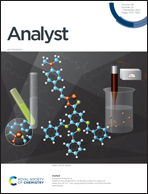In situ monitoring of the effect of Cu2+ on the membrane permeability of a single living cell with a dual-electrode tip of a scanning electrochemical microscope†
Abstract
Here, an Au–Cu dual-electrode tip was designed to monitor the effect of Cu2+ on the membrane permeability of a single living cell in situ using scanning electrochemical microscopy. The probe approach curves (PACs) were obtained using potassium ferricyanide as a redox mediator. Meanwhile, according to the simulation, theoretical PACs could be acquired. Thus, the cell membrane permeability coefficient (Pm) values were obtained by overlapping the experimental PACs with the theoretical values. Cu2+ was directly generated by electrolyzing the Cu electrode of the dual-electrode tip to investigate its effect on the cell membrane permeability in situ. This work has potential value to improve the understanding of the mechanism of acute heavy metal damage on the cell membrane and will also help clarify the role of heavy metal ions in physiological or pathological processes.



 Please wait while we load your content...
Please wait while we load your content...